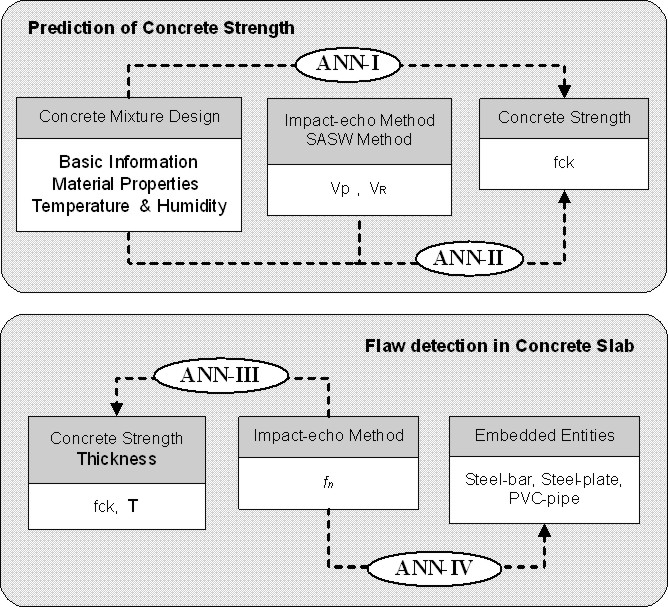
engineering & technology publications
ISSN 1759-3433
PROCEEDINGS OF THE EIGHTH INTERNATIONAL CONFERENCE ON THE APPLICATION OF ARTIFICIAL INTELLIGENCE TO CIVIL, STRUCTURAL AND ENVIRONMENTAL ENGINEERING
Neural-Network Based Models of a Diagnosis System for Concrete Structures using Non-destructive Test Data
+New Engineering Consultants Inc, Seoul, Korea
*Research Institute of Technology, Samsung Corporation (Eng. & Cons.), Bundang, Korea
$Department of Architectural Engineering, Hanyang University, Ansan, Korea
The system is composed of two modules. One is to predict the concrete strength that can provide in-place strength information of the concrete to facilitate concrete form removal and quality control of concrete structures. The other is to detect the flow of concrete that can predict thickness of concrete slabs and the kinds of embedded entities in concrete slabs to ensure the maintenance and safety evaluation of concrete structures.
The first module, for predicting the concrete strength, is classified as the ANN-I and the ANN-II models as shown in Figure 44.1. The ANN-I model [2] predicts the concrete strength based on basic information, material properties, measurement, temperature and humidity history from pouring day to 28th day after pouring. The ANN-II model predicts concrete strength based on additional non-destructive test data.
The second module, for detecting the concrete flaw, is classified as the ANN-III and ANN-IV models as shown in Figure 44.1. The ANN-III model predicts the concrete strength and the thickness of the concrete slab. The ANN-IV model can predict the kinds of embedded entities in concrete slab. For this, the results of non-destructive test as signals are used as training patterns in the ANN model.
- 1
- Abraham,O., Leonard, C., Cote, P and Piwakowski, B, "Time Frequency Analysis of Impact-Echo Signals: Numerical Modeling and Experimental Validation", ACI Materials Journal. Vol.97, No.6, pp. 645-657, 2000.
- 2
- S.C. Lee, "Prediction of Concrete Strength using Artificial Neural Network Model", Engineering Structures, vol.25, pp. 849-857, 2002. doi:10.1016/S0141-0296(03)00004-X
purchase the full-text of this paper (price £20)
go to the previous paper
go to the next paper
return to the table of contents
return to the book description
purchase this book (price £80 +P&P)
